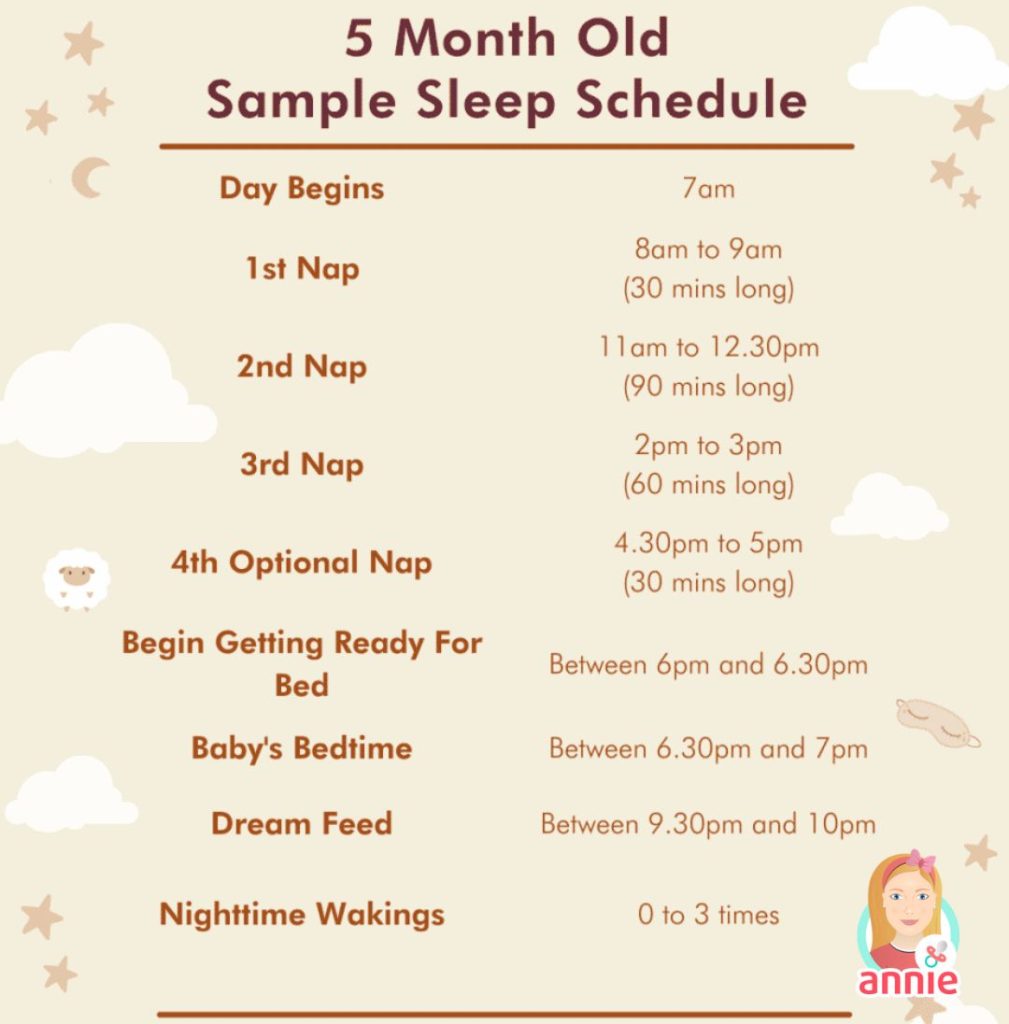
Infant Sleep Essentials: The Ultimate Guide To Drafting a 5 Month Old Sleep Schedule
- Created:
13. 11. 2023 - Updated:
13. 11. 2023
Newsflash:
At five months, your little one is growing fast.
And sometimes, their development can be hard to keep up with, especially their sleep patterns.
The truth is:
Your baby’s sleep patterns change as they develop. And as their parent, you have to help them navigate these changes.
But hear me out:
Although navigating your baby’s sleep patterns sounds challenging, with a 5 month old sleep schedule, it’s a total breeze.
So:
Join us as we explore the steps to creating a 5 month old sleep schedule that suits your baby.
The Importance of Sleep for a 5-Month-Old
As a parent, you’ve probably noticed that babies take their time sleeping. But you might be surprised to know how important sleep actually is to their well-being and growth.
The truth is:
Though they might not sleep as much as they did as newborns, 5-month-olds still need comfortable and adequate sleep.
For starters:
Like you and I, babies need sleep to catch some rest.
Now:
Babies burn a lot of energy learning new things, growing, and developing their brain functions, like memory. And this is a lot of work for them, considering they’re new to the world and its processes.
Thus:
With enough sleep, they can rejuvenate both their minds and bodies to prepare them for more developmental milestones.
Additionally:
5-month-old babies need sleep to aid their physical growth and mental development. Sleep encourages their brains to build up skills, including speech, memory, and attention to their environment.
So, as you can see:
They’re not just sleeping because they can. They’re sleeping because they have to.
Generally:
Babies around five months should spend 12-16 hours sleeping daily, according to the Sleep Foundation.
Around this age, their nighttime sleep is more established, so they can sleep for most of the night. So, they’d spend between 8-10 hours asleep at night and 3-4 hours asleep in the day.
And while they might not be ready to transition to one nap just yet, they’d only need about two naps per day.
Identifying Sleep Windows
Picture this:
You draft a 5 month old sleep schedule for your baby and lay them to sleep following it.
At first:
You expect your baby to fall asleep because you’ve set up the mood for their slumber quite nicely. Not to mention, their sleep environment is safe and comfortable.
But then:
You notice your baby doesn’t look sleepy at all. In fact, more than ever, they’re smiley and ready to play with you.
Trust me:
It’s a more common scenario than you might think.
Listen up:
Before you can draft an effective sleep schedule for your baby, you have to know what their sleep window is.
Fundamentally:
A sleep window is the period when the baby’s body and brain naturally want to go to bed. During this time, the baby’s brain recognizes that their body needs rest, so they present signs of exhaustion.
As such:
You can identify your baby’s sleep widow by looking out for the following signs of exhaustion:
- Droopy eyes
- Frequent yawning
- Reduced mobility
- Less cooing or babbling
- Ear pulling
- Fussiness
Now:
Each of these signs alone might not necessarily signify exhaustion. However, if your baby presents two or more of these signals, you should prepare them for bed.
In the end:
Once you’ve identified your baby’s sleep windows, you can design their sleep schedule to fit them. This ensures your baby actually goes to bed when you lay them down to rest.
Plus:
They get all the vital sleep they need.
Creating a 5-Month-Old Sleep Schedule: Step-by-Step Guide
To put it plainly:
There’s no rigid way to create a 5-month-old sleep schedule for your baby.
That’s right!
If I’m being honest, all babies are different. They express themselves differently, and their bodies function and develop in unique ways.
To this effect:
While creating a sleep schedule, you must ensure that you’re listening to your baby’s cues and needs.
With that said:
We will explain the steps to creating the perfect 5-month-old sleep schedule for your baby below:
1. Observe Your Baby’s Natural Rhythms
Fundamentally:
Before creating a sleep schedule for your infant at any age, you must find out what works for them first.
I’ll elaborate:
Internal waves called circadian rhythms regulate how often, when, and how deeply your baby sleeps. These circadian rhythms are present due to the interaction of hormones like melatonin, which induces sleep, and external factors.
You read right:
External factors like light and sound intensity can affect your baby’s circadian rhythms and disrupt their sleep.
But it doesn’t stop there:
Your actions can disrupt your infant’s sleep, too. If your baby already finds a certain sleeping pattern comfortable, interrupting that pattern can affect their circadian rhythms.
And when this happens, your baby begins to find it difficult to sleep. They might even begin to fight sleep as well.
As such:
It’s never a good idea to force your baby out of their natural sleeping patterns.
Rather:
You have to observe their natural rhythms and curate a sleep schedule that fits those patterns. An excellent way to do this is by keeping a sleep log or diary.
Basically:
The sleep log or diary is a platform for you to record the time your baby sleeps and their sleep duration. You can either keep this record using a notebook or software on your phone.
Essentially:
A sleep log or diary allows you to observe and analyze your baby’s sleeping patterns. So when it’s time to create their schedule, you can refer to the record and set up the schedule accordingly.
2. Establish a Bedtime Routine
We can all testify to it:
Babies thrive off of routines.
Here’s why:
Your little superhuman is quite new to the world at five months. So, they haven’t really gotten the hang of how the world works at this age.
However:
They do grow at an astonishing pace. And as they do so, their brains pick up regularly occurring events and store them as normal.
This is why you might notice your baby opening their mouths when you bring your hands close to them. To their little mind, a hand to their mouth means it’s time for some food.
In the same vane:
Setting up a bedtime routine for your baby tells them it’s time for bed.
Now:
The good news is that setting up your 5-month-old’s bedtime routine doesn’t have to be rigorous. You could simply dim the lights, rock them, or sing them a lullaby.
These activities keep your baby calm so they can feel safe enough to fall asleep and stay asleep.
For example:
When you rock your baby and sing them a lullaby, you make them feel protected in your arms. And, since your voice already sounds familiar to them at this age, they can feel safe enough to sleep.
If you want to take it up a notch, you can add white noise to mimic the sounds of the womb. As a result, this sound lulls the baby into a deep and comfortable sleep.
3. Set a Consistent Wake Time
Ultimately:
Your baby’s wake time determines how long or how short their sleep and wake windows will be.
And as a parent looking to optimize their baby’s sleep, such a factor is quite important.
As we’ve earlier established:
Babies love patterns and consistency.
Thus:
Setting a consistent wake time for them lets the baby adapt to that structure and wake around that time naturally.
However:
Wake times are one thing you shouldn’t force your infant to adapt to. If you notice that the wake time doesn’t provide your baby enough sleep, you have to adjust it so it does.
In essence:
The perfect wake time for your baby resonates with their natural rhythms. Hence, it enables them to get optimum sleep with a reduced risk of overtiredness.
With that said:
When setting your baby’s wake time, you must consider their natural sleep patterns and the time they wake daily.
If you keep a sleep log or diary, this part won’t be too difficult.
The thing is:
Setting your baby’s wake time doesn’t necessarily mean you get to dictate when they wake and how long they sleep.
It means you get to converge their scattered wake times to provide a steady pattern for the baby.
So:
Once you’ve set a wake time according to your baby’s natural sleep patterns, you can wake them around that time. You can gradually go from their natural wake time to the new wake time to give them room to adapt.
Over time:
With maintained consistency, you’d notice that this wake time would become your baby’s natural wake time.
4. Plan Nap Times
At five months, your baby’s nighttime sleep is pretty much solidified. They can go long hours sleeping at a stretch or wake up once or twice throughout the night.
Considering this:
Their solidified nighttime sleep leaves only a few hours of sleep for the day. So they might not be having just one nap daily yet. However, their naps reduce to 2-3 per day.
Now:
Once your baby hits the five-month-old mark, a lot of things are going to change. Their arms and legs grow stronger, their teeth start to come in, and they might even attempt to crawl.
To this effect:
Just like you, they will get increasingly interested in exploring their cool new superpowers.
As a result:
They’ll start sleeping less during the day.
But remember:
Part of helping your baby navigate their growth is ensuring they get enough sleep to encourage them. Plus, if you think about it, there’s a reason why daytime sleep sessions are called power naps.
Basically:
You must spread out their naps throughout the day so they don’t spend too much time awake or asleep. Planning your baby’s nap times provides this balance and ensures their sleep isn’t just adequate but effective, too.
For example:
If your baby gets three naps daily, they can get one nap each in the morning, afternoon, and evening.
5. Include Time for Feedings
Even as adults, we can agree that hunger and sleep aren’t the best of allies.
Moreso:
Babies, who are constantly using their energy supply to drive growth and development, need food as much as we do.
As a result:
Your baby’s sleep schedule has to align with their feeding schedule.
Think about it:
At five months, your baby is bagging 12-16 hours of sleep, most of which are in long stretches. And with their body’s demand for energy and nutrition, they can get hungry while they’re asleep.
And, of course, they’d express how unhappy they are in such a scenario.
Not to mention:
It could disrupt your routine as well.
Even worse:
If this goes on for a while, your baby could develop a sleep regression, or they might fight sleep. And that’s never good.
To this effect:
It’s always a good idea to feed your 5-month-old closer to their bedtime so they don’t get hungry while sleeping.
And during the day, you can feed them just after their naps.
Sample 5-Month-Old Sleep Schedule
You can admit it:
Creating a 5-month-old sleep schedule looks like it would take time, especially since it has to match your baby’s natural patterns.
Not to mention:
With how busy parenting can get, there’s barely any time to draft a 5-month-old sleep schedule from scratch.
I have the solution right here:
Below, I’ve drafted a sample 5-month-old sleep schedule to help guide you while creating yours. For this sample, the baby wakes at 7:00 am:
| Nap | Nap Time Interval | Nap Duration | Wake Window |
|---|---|---|---|
| 1st nap | 9:00 am – 10:30 am | 1 hour and 30 minutes | 2 hours after morning wake |
| 2nd nap | 12:00 am – 1:30 pm | 1 hour and 30 minutes | 1 hour and 30 minutes after 1st nap |
| 3rd nap | 3:30 pm – 5:00 pm | 1 hour and 30 minutes | 2 hours after 2nd nap |
For this schedule:
The baby’s bedtime routine can come in by 6:30 pm so they can get to bed by 7:00 pm.
Remember:
When tweaking the schedule to fit your 5-month-old’s patterns, ensure the wake time isn’t far from their natural wake time.
Note:
Your baby’s nap duration shouldn’t be too short or too long to prevent them from getting overtired. For five-month-olds, their naps should be within 30 minutes to two hours per nap.
Also:
Consistency is key.
So, while your baby might not adhere strictly to the sleep schedule initially, with patience, they will adapt to it.

Final Tip: Annie Baby Monitor – Your Sleep Helper for Newborns
Babies and their sleeping habits can be quite puzzling!
But don’t worry, with Annie Baby Monitor’s baby tracking feature, you can keep an eye on your little one’s sleep patterns without any hassle.
Annie Baby Monitor baby tracker allows you to keep a watchful eye on your newborn’s sleep duration. By collecting and analyzing this valuable data, you can identify patterns and create a sleep routine that suits your baby’s needs.

So, if you’re navigating the newborn sleep, let Annie Baby Monitor be your trusted sleep helper.
Conclusion
Wrapping up:
5-month-old sleep schedules are quite easy to create. However, you have to put in a conscious effort to create one.
Fundamentally:
You must identify and record your baby’s sleep windows.
Here are some steps to creating a 5-month-old sleep schedule:
- Observe their natural rhythms
- Establish a bedtime routine
- Set a consistent wake time
- Plan nap time
- Include time for feedings
In addition:
To take some of the stress off your shoulders, you can use our sample 5-month-old sleep schedule as a template.
Remember:
Babies need sleep. One sure way to ensure they get adequate and optimum rest is by using a balanced sleep schedule.
As always:Don’t forget to leave a comment below if this article was helpful to you. You can also drop your questions and suggestions, and I’ll be sure to reply.






